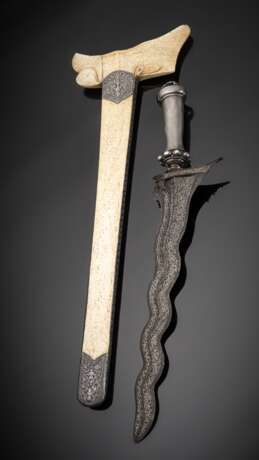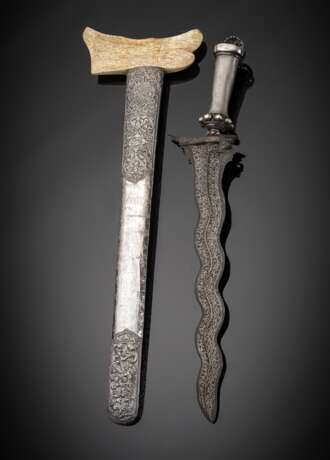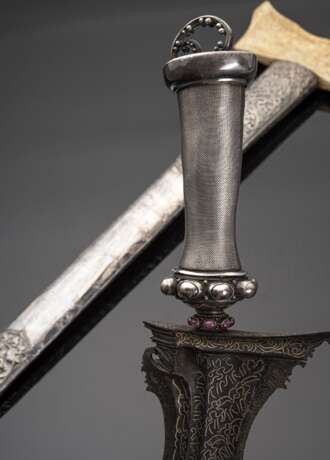ID 1218051
Lot 1534 | Keris
Estimate value
€ 5 000 – 8 000
L. 43 (Klinge) / 81 cm
Die Klinge dieses außergewöhnlichen Keris ist gewellt, in 9 Wellen (luk), in der Form sempana. Außergewöhnlich mächtige Klinge ohne pamor (kelengan). Inschriften in Silbertausia, im muslimischen Kontext. Bedeutung: la ilaha ilallah Muhammad rasulluh - kein Gott außer Allah und Mohamed ist sein Prophet Allahs. Der sorsoran (die Klingenbasis) ist mit den charakteristischen Eisenschnittelementen versehen. Diese beinhalten: jenggot, greneng, sekar kajang, tikel alis, lambe gajah. In ihrer Gesamtheit nehmen sie auf den Elefanten als hinduistisches Symbol von Macht sowie legitimer Herrschaft Bezug. Die Klinge ist aufgrund der greneng-Ausprägung wohl javanischer Herkunft, sie stammt aus dem 18. Jahrhundert oder ist noch älter. Ähnliche Klingen werden teilweise der Mataram-Kartasura-Ära zugewiesen (vgl.SNKI 2010: 334). Der Griff ist in grantim-Form gehalten und in besonders hoher Qualität ausgeführt, mit feinst geflochtenen Silberfäden als Bezug des Holzkerns. Oben ist der eingerollte Schweif eines Tieres oder Pflanzensprosses erkennbar. Die Scheide hat ein Mundstück in sesrengetan-Bootsform, javanisch ist sie als ladrang bekannt. Die formale Vorlage dürfte ein Schiff sein, In Bezugnahme auf austronesische Ursprungsmythen. Der Scheidenkorpus ist aus Walknochen, mit einem Scheidenüberzug aus sehr fein getriebenem Silber. Die Bevölkerung Lomboks setzt sich aus 85% Sasak, 10 bis 15% Balinesen und Minderheiten von Chinesen, Arabern, Javanern und Sumbawanesen zusammen. Auf Lombok werden Indonesisch und verschiedene Dialekte der Sasak-Sprache gesprochen. Die Sasak sind ethnisch und kulturell eng mit den Balinesen verwand. Etwa 90% der Einwohner Lomboks sind seit dem 16. Jahrhundert Anhänger des Islam, der auf Lombok in seiner überwiegend orthodoxen Form Waktu Lima genannt wird. Eine geringe Minderheit der Sasak sind Anhänger der synkretistischen Religion Waktu Telu, einer Mischung aus Islam, balinesischem Hinduismus und Ahnenkult.
Aus einer alten deutschen Privatsammlung, seit den 1950er Jahren gesammelt - Minim. Altersspuren
Lit: SNKI (2011): Keris untuk Dunia (Keris for the World). Jakarta. - A. Weihrauch (2002): Ursprung und Entwicklungsgeschichte des indonesischen Kris. Historische und metallurgische Untersuchungen. Basel (Dissertation). - IFICAH (2015): Götter-Schmiede. Balinesische Zeremonialklingen im kulturellen Kontext. Wohlesbostel. - Neka, P.W.S. (2010): Keris Bali Bersejarah. Neka Art Museum, Ubud.
| Auction house category: | Ethnographic tribal art |
|---|
| Auction house category: | Ethnographic tribal art |
|---|
| Address of auction |
Nagel Auktionen GmbH Neckarstrasse 189 - 191 70190 Stuttgart Germany | ||||||||||||||
|---|---|---|---|---|---|---|---|---|---|---|---|---|---|---|---|
| Preview | |||||||||||||||
| Phone | +49 (0)711 649 690 | ||||||||||||||
| Fax | +49 (0)711 649 69696 | ||||||||||||||
| Buyer Premium | 29,5% | ||||||||||||||
| Conditions of purchase | Conditions of purchase | ||||||||||||||
| Business hours | Business hours
|





